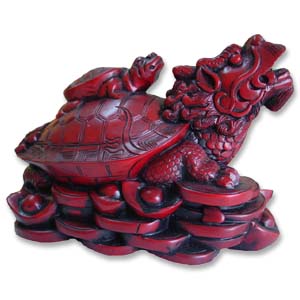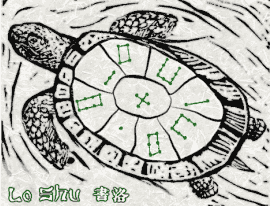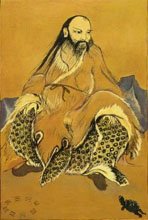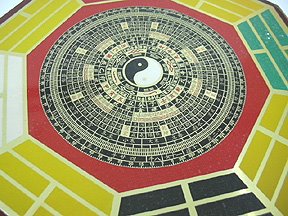 You may have heard about the Feng Shui Money Frog - a strange creature that is supposed to bring great riches to its owner. But why? And how?
You may have heard about the Feng Shui Money Frog - a strange creature that is supposed to bring great riches to its owner. But why? And how?
Read a testimonial from one of my clients after installing a Money Frog at his office.
The History
To the Chinese, the frog symbolizes the moon -
"the lunar, yin principle" and brings healing and prosperity.
The Feng Shui Money Frog is called "Chan Chu" in China (literally "wealth-beckoning toad").
Traditionally, it is depicted holding a Ching Dynasty coin in its mouth and sitting on piles of gold ingots, coins and wealth.
On the back of the
King Chan Chu are 7 diamond dots depicting the Ursa Major. The study of Chinese Elemental Astrology is based on the 7 stars, which, when coupled with 2 hidden supporting stars represent the 9 Stars of the Bagua, which is the basis for all study on Feng Shui.
The Bagua also protects against loss of the money gained.
Another type of Money Frog carries a string of chinese coins tied behind its back. The Chinese believe this frog is a symbol of your cash flow, so of course the bigger the frog the bigger the cash flow.
The Legends
One legend says that the Money Frog exists on the moon. When there is an eclipse, the frog appears to swallow the moon.

Another legend claims that the Money Frog was originally
Chang Ngo, the wife of a legendary figure. She was greedy, and stole the Elixir of Immortality from Goddess of the West (
Hsi Wang Mu).
The other deities in heaven punished Chang Ngo for this, by transforming her into a three legged frog and banishing her to the moon. Now whenever people see the Money Frog, there is a bed of money surrounding it because
Chang Ngo is naturally greedy. For generations, this mythical frog has been the holy creature that protects against misfortune and promises to bring riches and wealth to the household.

Also related is
Lui Hai, one of the 8 Immortals. He was a Minister of State who lived during the Tenth Century.
Lu Hai knew of the frog's fondness for money, so he used bait (a red line tied with gold coins) to lure the frog from hiding. Because of this, it has become popular that a frog with coins symbolizes that wealth is about to come and greet you.
Read all about the History of Feng Shui at Feng Shui Style.
Types of Money Frogs:
Jade and precious stones

Real jade Money Frogs are excellent, because they literally ARE precious, and are said to offer protection to businesses.
Send us an email at
jennifer@fengshuistyle.us to inquire about Jade Money Frogs. They are only available at one place in Chinatown. We have an exclusive arrangement with the owner, and this is where we get all of our Jade Money Frogs.
We can get you any size you like. They range from $125 to $3000, depending on size.
Rosewood Resin (Red)
Red frogs are the most "Yang", so they activate the wealth energy. This particular frog comes with a porcelain dish filled with loose sodalite crystals. Crystals are famed as energy cleansers and will provide a positively-charged environment. Both of these items should be placed together in the appropriate areas of the home and office for the best Feng Shui.
Gold or Bronze
These frogs are said to appear every full moon, bringing good news and wealth to the people nearby. Gold is considered one of the symbols of wealth so for greater luck and energy, place at least one money frog on a bowl full of golden coins.
 Where to Place your Money Frogs:
Where to Place your Money Frogs:
One of the most auspicious places is inside, in the wealth area (Southeast) and across from the front door on a diagonal.
This allows the frog to view the front door. It is important for the frog to have the coin in its mouth with the good luck symbol facing up. You can glue the coin in so it does not fall out or get lost. The coin should also be facing the front door; it is as if the frog is saying, "I will catch all your money here ... bring it on!"
To learn about how to pump up all the areas of your life, go to Feng Shui Style.
Important: Some people believe you should turn your money frog around at night, to face inward. This is said to "keep" the money that you accumulate.
How many frogs should I get and what size?
For an average size room or office select a frog about three inches high and three inches wide. Larger frogs are fine for larger spaces - buy the biggest one you can afford.
You can use as many as 9 money frogs (the number of completion), but if you do they should be smaller frogs.
You can place them everywhere except the kitchen, bathroom and bedroom.
- You may place Money Frogs in your living room area or where you conduct business.
- You may place a frog in each corner of your Bagua.
- They should not be immediately obvious to visitors.
- They should not be on the ground, up too high, or above the height of the pockets of people coming into your home or office.
- No one should enter feeling as though you want their money.
When using Money Frog cures it is important to check in with yourself and see if this does indeed create a feeling of wealth for you and see if you have a personal connection to your Money Frog.
Before I studied Feng Shui I intellectually "got" what the Money Frog meant but I felt the cures did not work as well because I didn’t have a sincere appreciation for the background and legend of the frog. After I completed my Feng Shui study, I understood the Money Frog on a cellular level, and now they work brilliantly for me.
Get a Feng Shui Consultation
today for your home or office at
Feng Shui Style.


























